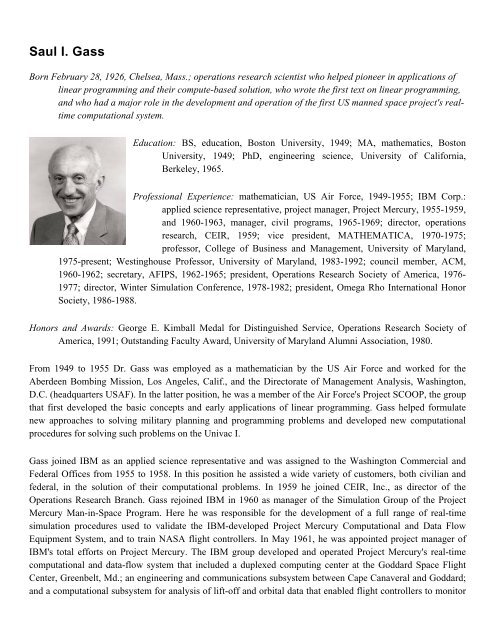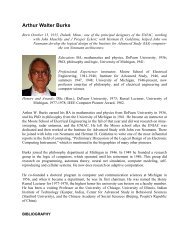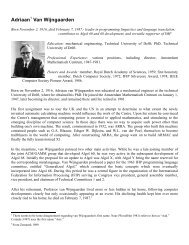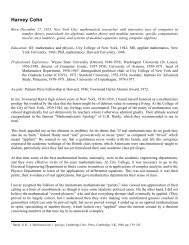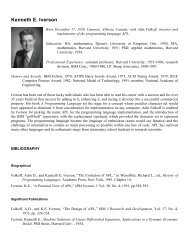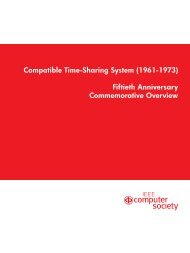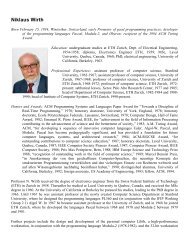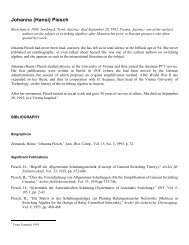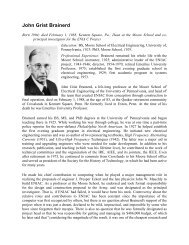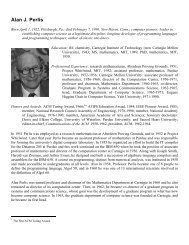Saul I. Gass - Walden Family
Saul I. Gass - Walden Family
Saul I. Gass - Walden Family
You also want an ePaper? Increase the reach of your titles
YUMPU automatically turns print PDFs into web optimized ePapers that Google loves.
<strong>Saul</strong> I. <strong>Gass</strong><br />
Born February 28, 1926, Chelsea, Mass.; operations research scientist who helped pioneer in applications of<br />
linear programming and their compute-based solution, who wrote the first text on linear programming,<br />
and who had a major role in the development and operation of the first US manned space project's realtime<br />
computational system.<br />
Education: BS, education, Boston University, 1949; MA, mathematics, Boston<br />
University, 1949; PhD, engineering science, University of California,<br />
Berkeley, 1965.<br />
Professional Experience: mathematician, US Air Force, 1949-1955; IBM Corp.:<br />
applied science representative, project manager, Project Mercury, 1955-1959,<br />
and 1960-1963, manager, civil programs, 1965-1969; director, operations<br />
research, CEIR, 1959; vice president, MATHEMATICA, 1970-1975;<br />
professor, College of Business and Management, University of Maryland,<br />
1975-present; Westinghouse Professor, University of Maryland, 1983-1992; council member, ACM,<br />
1960-1962; secretary, AFIPS, 1962-1965; president, Operations Research Society of America, 1976-<br />
1977; director, Winter Simulation Conference, 1978-1982; president, Omega Rho International Honor<br />
Society, 1986-1988.<br />
Honors and Awards: George E. Kimball Medal for Distinguished Service, Operations Research Society of<br />
America, 1991; Outstanding Faculty Award, University of Maryland Alumni Association, 1980.<br />
From 1949 to 1955 Dr. <strong>Gass</strong> was employed as a mathematician by the US Air Force and worked for the<br />
Aberdeen Bombing Mission, Los Angeles, Calif., and the Directorate of Management Analysis, Washington,<br />
D.C. (headquarters USAF). In the latter position, he was a member of the Air Force's Project SCOOP, the group<br />
that first developed the basic concepts and early applications of linear programming. <strong>Gass</strong> helped formulate<br />
new approaches to solving military planning and programming problems and developed new computational<br />
procedures for solving such problems on the Univac I.<br />
<strong>Gass</strong> joined IBM as an applied science representative and was assigned to the Washington Commercial and<br />
Federal Offices from 1955 to 1958. In this position he assisted a wide variety of customers, both civilian and<br />
federal, in the solution of their computational problems. In 1959 he joined CEIR, Inc., as director of the<br />
Operations Research Branch. <strong>Gass</strong> rejoined IBM in 1960 as manager of the Simulation Group of the Project<br />
Mercury Man-in-Space Program. Here he was responsible for the development of a full range of real-time<br />
simulation procedures used to validate the IBM-developed Project Mercury Computational and Data Flow<br />
Equipment System, and to train NASA flight controllers. In May 1961, he was appointed project manager of<br />
IBM's total efforts on Project Mercury. The IBM group developed and operated Project Mercury's real-time<br />
computational and data-flow system that included a duplexed computing center at the Goddard Space Flight<br />
Center, Greenbelt, Md.; an engineering and communications subsystem between Cape Canaveral and Goddard;<br />
and a computational subsystem for analysis of lift-off and orbital data that enabled flight controllers to monitor
all phases of a Project Mercury mission. In 1963, he received an IBM resident graduate fellowship and<br />
completed his doctoral studies in operations research at the University of California, Berkeley, in 1965. For his<br />
dissertation, <strong>Gass</strong> developed the duplex method for the solution of large-scale linear-programming problems<br />
under the supervision of George B. Dantzig.<br />
In 1966 <strong>Gass</strong> was a full-time member of the Science and Technology Task Force of the President's Commission<br />
on Law Enforcement. He was responsible for developing the Task Force's approach to how science and<br />
technology can best serve law enforcement agencies. For the IBM Federal Systems Division (1966-1970), he<br />
was manager of federal civil programs and was responsible for applying information retrieval and other data<br />
procedures, advanced graphic techniques, and operations research to urban problems.<br />
<strong>Gass</strong> joined MATHEMATICA, Inc., in 1970, and managed the operations research projects being conducted in<br />
the Washington, D.C., area. He joined the University of Maryland as professor and chairman (1975-1979) in<br />
Management Science and Statistics of the College of Business and Management. <strong>Gass</strong> has served as a<br />
consultant to the US General Accounting Office, the National Institute of Standards and Technology, and other<br />
federal and private operations research and systems analysis organizations.<br />
BIBLIOGRAPHY<br />
Significant Publications<br />
<strong>Gass</strong>, <strong>Saul</strong> L, Linear Programming, McGraw-Hill, New York, 1958 (5th edition published in 1985).<br />
<strong>Gass</strong>, <strong>Saul</strong> I., An Illustrated Guide to Linear Programming, McGraw-Hill, New York, 1970.<br />
<strong>Gass</strong>, <strong>Saul</strong> L, Decision Making, Models, and Algorithms, John Wiley and Sons, New York, 1985.<br />
<strong>Gass</strong>, <strong>Saul</strong> L, and R. Sisson, A Guide to Models in Government Planning and Operations, Sauger Books,<br />
Potomac, Md., 1975.<br />
UPDATES<br />
Portrait replaced (MRW, 2012)


